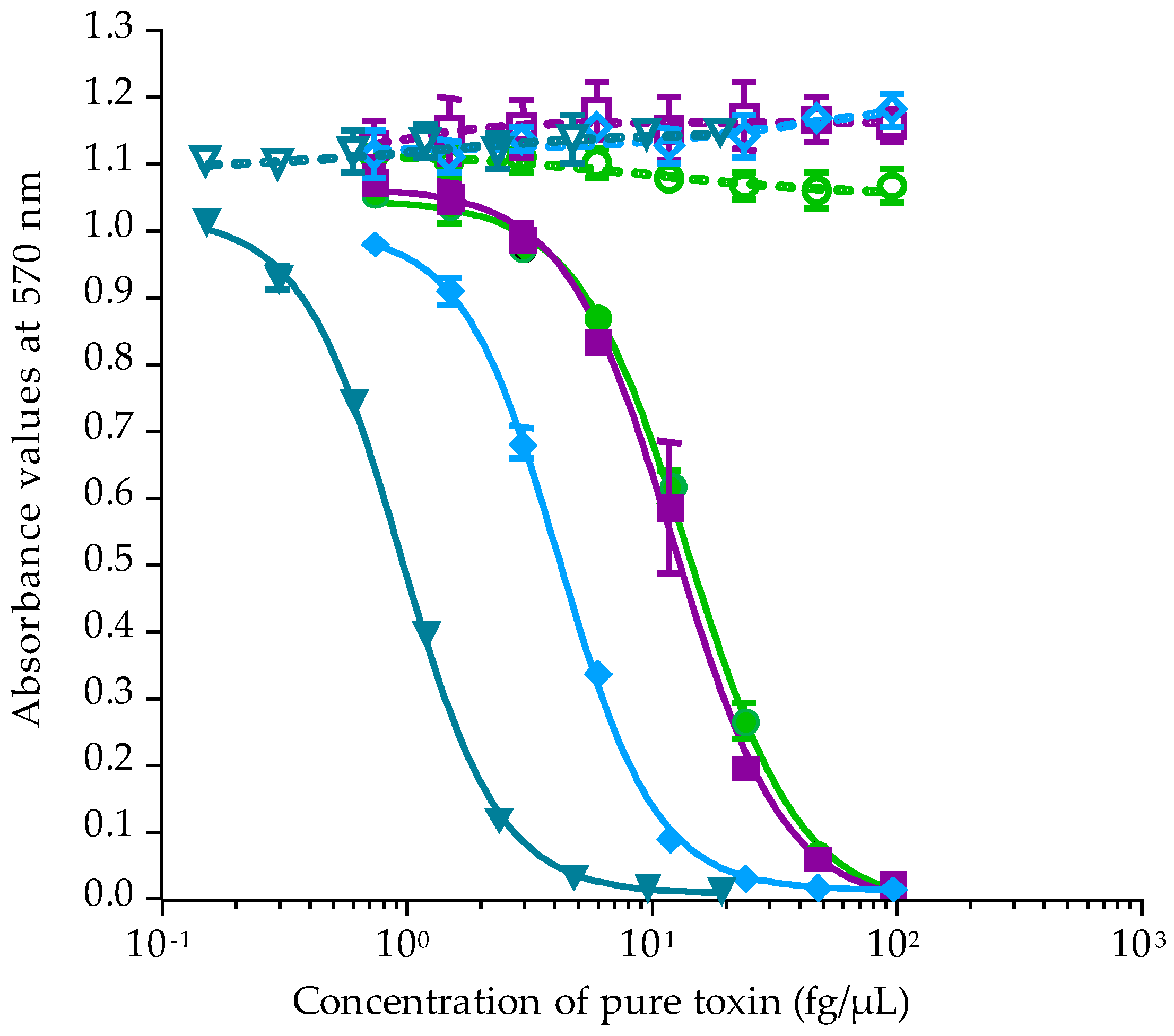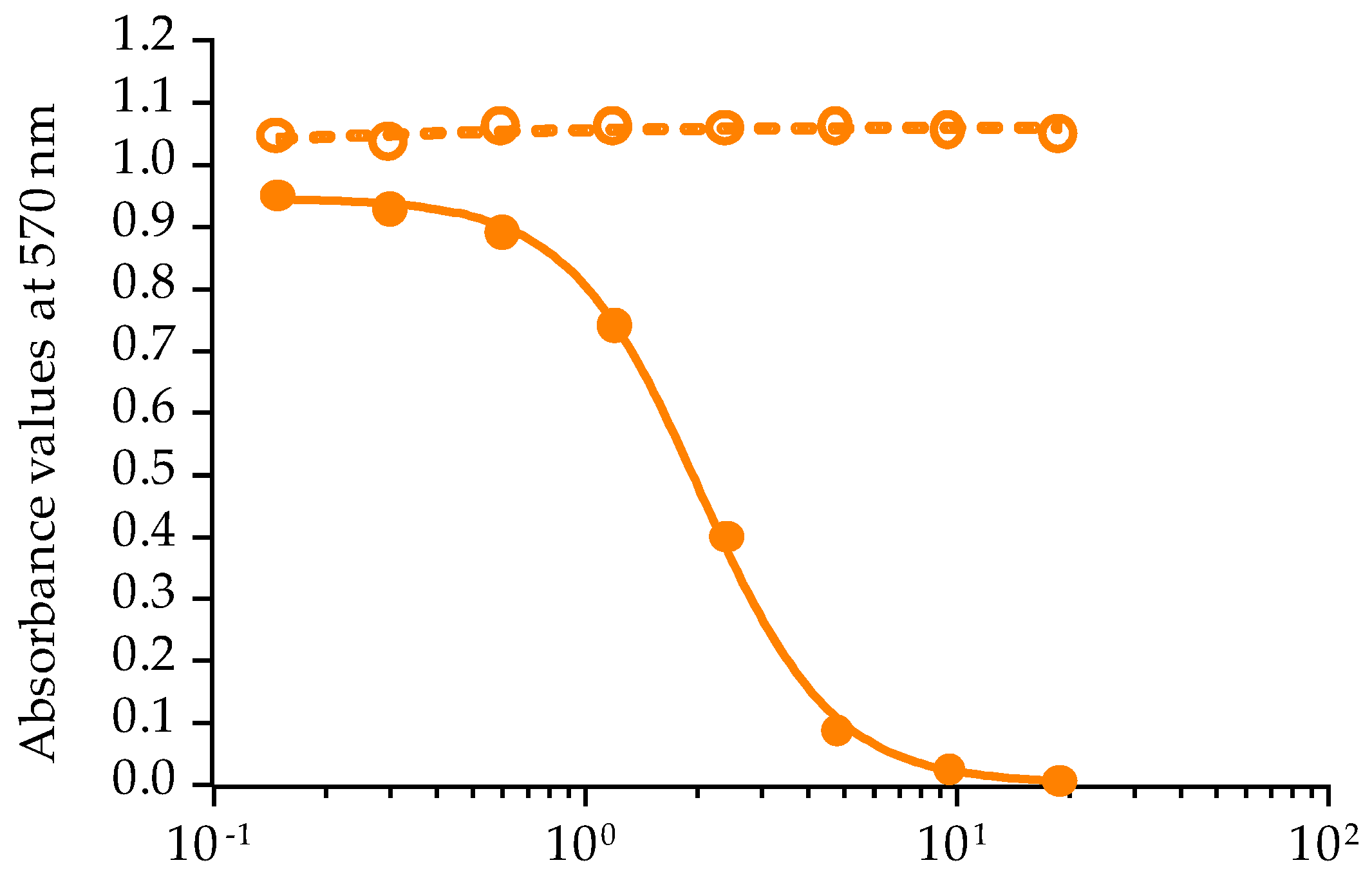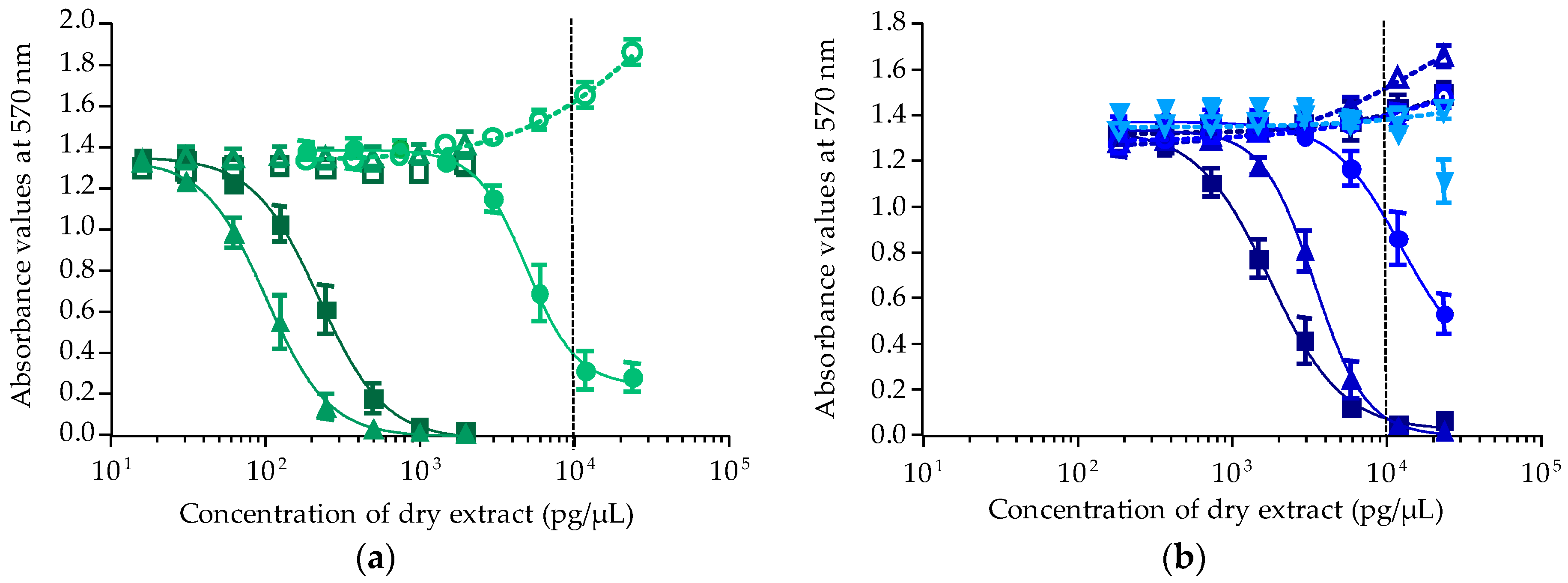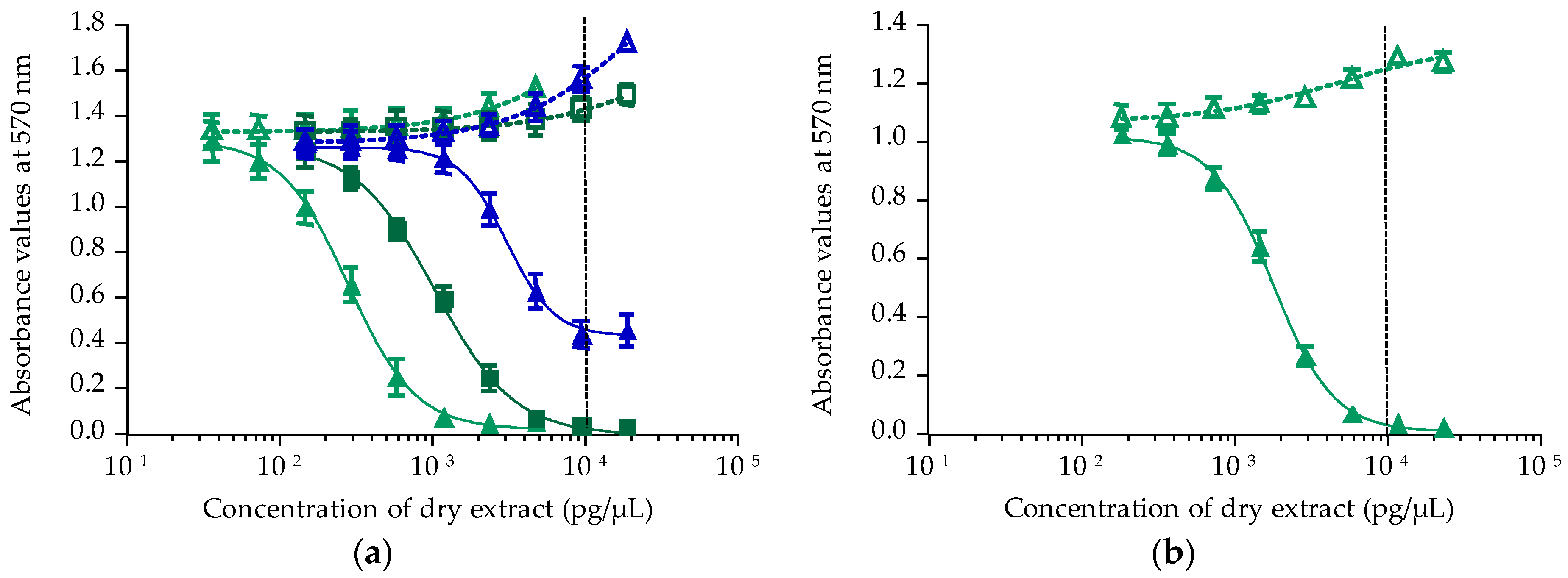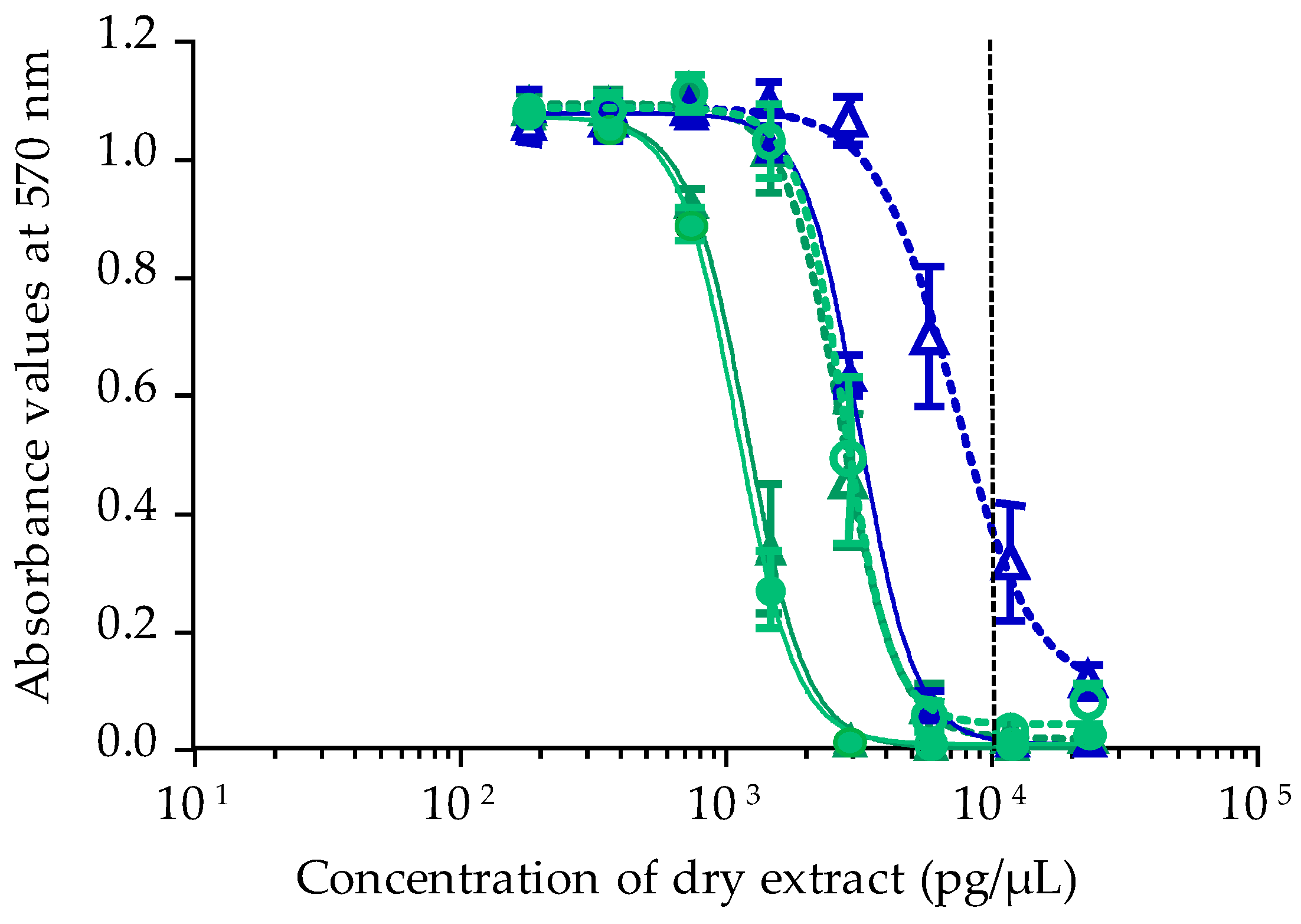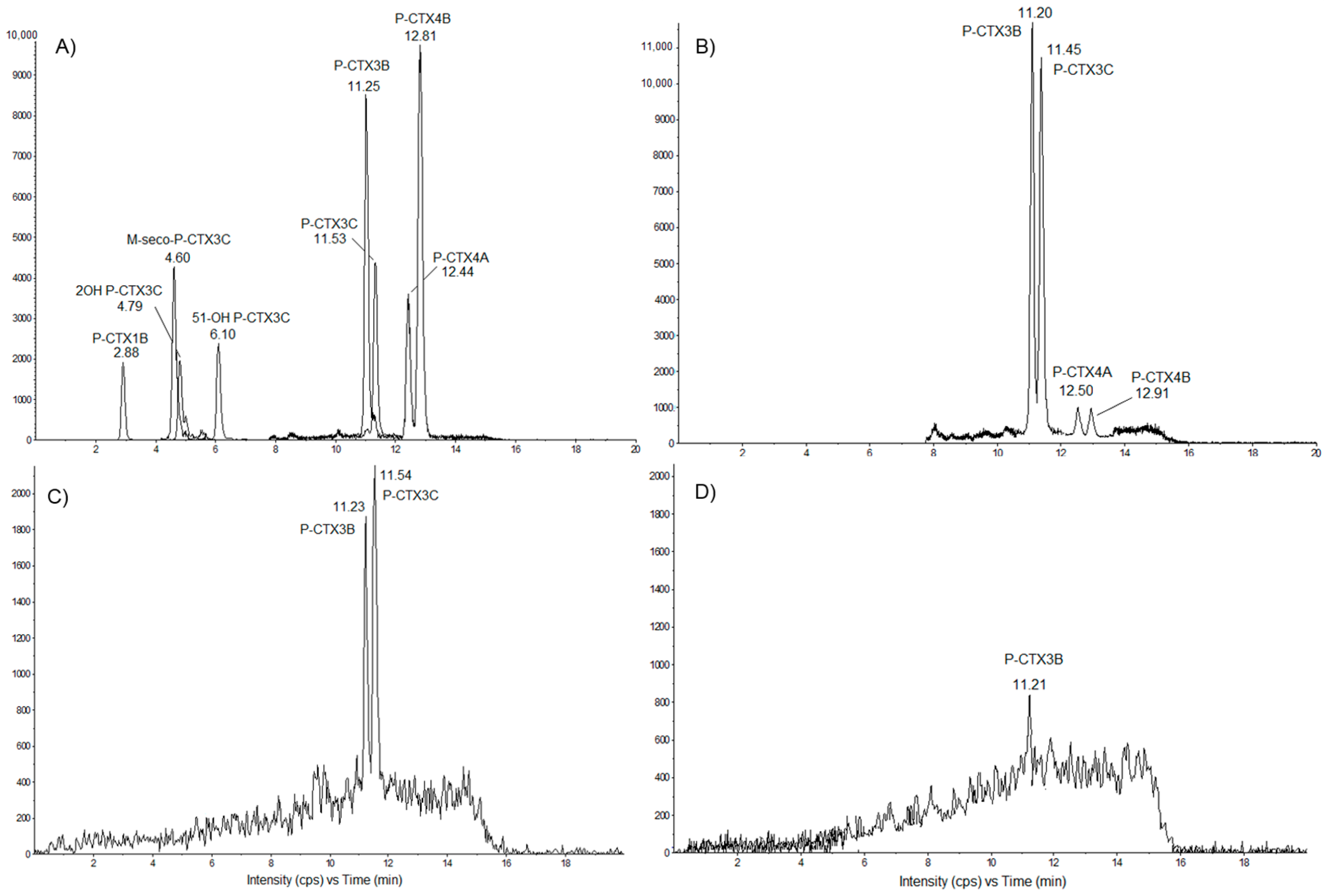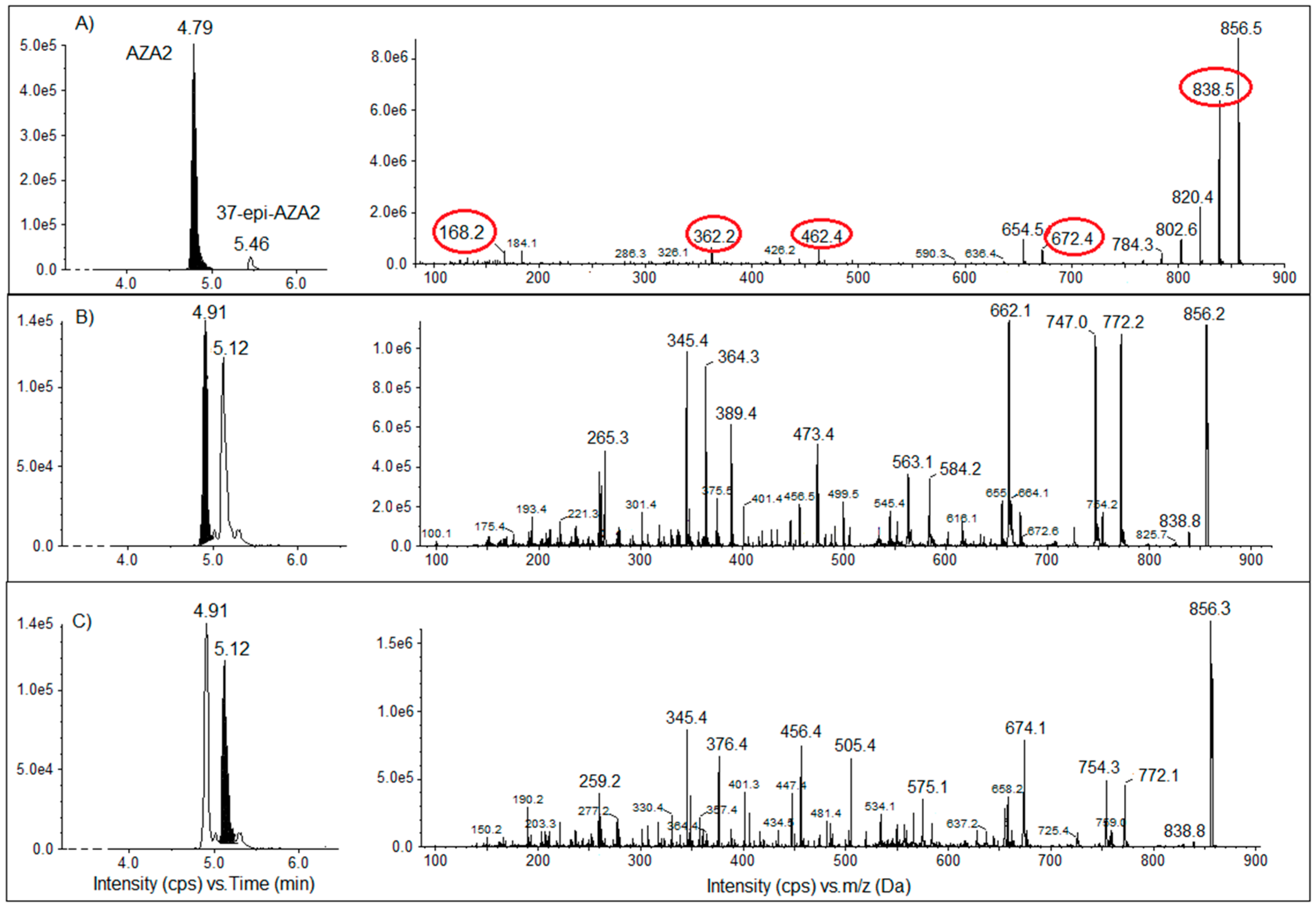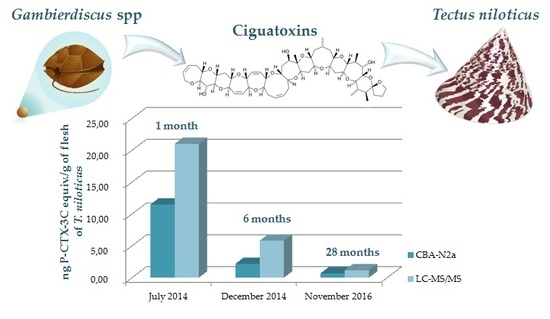1. Introduction
Tectus niloticus Linnaeus, 1767 (Gastropoda, Trochoidea, Tegulidae), a large, herbivorous marine snail widespread throughout Southeast Asia and the Western Pacific, is commonly known as trochus or top shell [
1,
2,
3]. It can be found in both intertidal and subtidal reef habitats, generally in high energy sections of the reef. The optimum depth for
T. niloticus is between 0 and 15 m, although individuals can be found as deep as 25 m [
3,
4]. Juveniles are quite cryptic, but larger individuals are often found on tropical coral reef flats [
3,
5].
T. niloticus are herbivores and tend to eat turf algae and biofilm by grazing on corals and rocks [
6,
7].
T. niloticus has been introduced to many South Pacific Islands and is usually fished artisanally for its shell, which is used to make traditional ornaments by indigenous people, as well as in the manufacture of mother-of-pearl buttons, which can be a valuable source of income for people in the Indo-Pacific region [
2,
6,
8,
9]. The shell is also used in cosmetics and paint [
3,
10]. In addition,
T. niloticus meat represents a valuable source of protein for many communities in Asian, as well as Pacific Island Countries and Territories (PICTs) [
6,
11]. Primary harvesters of trochus shells include Indonesia, the Philippines and Thailand, while Japan, Hong Kong and Europe are the most important consumers [
10,
12].
T. niloticus was introduced in French Polynesia from the Republic of Vanuatu as early as 1957 to establish a fishery [
13], but due to abusive exploitation, a law was issued in 1988 to protect this resource through a permanent fishing closure. However, there are limited fishing seasons authorized by the government with size limits and set quotas for the trade of mother-of-pearl and for consumption by local populations [
14].
In June 2014, a mass-poisoning outbreak involving nine tourists occurred in Nuku Hiva Island (Marquesas archipelago, French Polynesia) following the consumption of
T. niloticus collected from Anaho Bay [
15,
16]. All patients exhibited clinical symptoms typical of ciguatera fish poisoning (CFP), i.e., gastrointestinal (vomiting/diarrhea), cardiovascular (bradycardia and hypotension) and neurological (asthenia/myalgia, paresthesias/dysesthesias/cold allodynia) disorders, as well as symptoms like burning/tingling sensation of the mouth and throat [
15,
16]. Of note were atypical features such as the rapid onset (2 h) and unusual severity of gastro-intestinal and neurological symptoms, which necessitated the hospitalization of six patients [
15,
16].
CFP is a food-borne poisoning known to be caused primarily by the ingestion of coral reef fishes contaminated by potent neurotoxins, ciguatoxins (CTXs), originating from benthic dinoflagellates in the genus
Gambierdiscus [
17,
18]. However, ciguatera poisoning incidents involving marine invertebrates such as giant clams (e.g.,
Tridacna maxima,
Hippopus hippopus) or sea urchins (
Tripneustes gratilla) are also currently reported in PICTs (French Polynesia, New Caledonia, Cook Islands, the Republic of Vanuatu, etc.) [
19,
20,
21,
22]. A recent study by Roué et al. (2016) provided confirmation that giant-clams (
T. maxima) are actually able to bioaccumulate CTXs when exposed to
Gambierdiscus cells [
23].
Since
T. niloticus are herbivores and commonly graze on epiphytic organisms or those growing on biofilms [
7], they can potentially bioaccumulate marine biotoxins in their tissues, e.g., upon feeding on toxic micro-algae from benthic assemblages. The aim of this study was to assess the toxicity of
T. niloticus specimens collected from the toxic area of Anaho Bay over a two-year period and compare the data with two other sites on Nuku Hiva Island, Taipivai and Taiohae Bays. In addition, quantitative polymerase chain reaction (qPCR) assays were used to identify dominant
Gambierdiscus species present at the sampling sites, as well as in clonal cultures established from the field-collected material. Toxicological analyses were carried out using the neuroblastoma cell-based assay (CBA-N2a) to test for the potential presence of toxins in
T. niloticus samples. In addition, liquid chromatography coupled to tandem mass spectrometry (LC-MS/MS) was used for both identification of ciguatoxin analogues and multi-toxin screening for a variety of other marine toxins. These include: neurologic shellfish toxins (NSP), i.e., brevetoxins (PbTX1 to PbTX10), paralytic shellfish poisoning (PSP) toxins, i.e., carbamates (STX, NEO-STX, GTX1-GTX4),
N-sulfocarbamoyl (GTX5, GTX6 and C1 toC4) and decarbamoyls (dcSTX, dcNEO, dcGTX1-dcGTX4); diarrhetic shellfish poisoning (DSP) toxins i.e., okadaic acid (OA), dinophysistoxins (DTXs), pectenotoxins (PTXs), azaspiracids (AZAs) and yessotoxins (YTXs); cyclic imines (fast action toxins (FAT)): gymnodimines (GYMs), spirolides (SPXs) and pinnatoxins (PnTXs).
3. Discussion
A food poisoning outbreak involving nine tourists following the consumption of the gastropod
Tectus niloticus was reported from Anaho Bay, Nuku Hiva Island (Marquesas archipelago, French Polynesia) in June 2014 [
15,
16]. All patients exhibited clinical symptoms typical of CFP [
15]. As this poisoning incident involved an unusual vector of CFP, a toxicological survey of
T. niloticus toxicity harvested from three distinct fishing sites in Nuku Hiva Island was conducted during a two-year period using both CBA-N2a and LC-MS/MS analysis.
CBA-N2a and LC-MS/MS results revealed the presence of high levels of P-CTXs only in
T. niloticus specimens collected from Anaho Bay, in the same area where trochus specimens involved in the June 2014 mass-poisoning incident were harvested. Of note, the total toxin content in
T. niloticus specimens on three distinct occasions, from July 2014 until November 2016, was found to be consistently above the safety limit recommended for human consumption, even 28 months after the poisoning outbreak occurred in Anaho Bay. Such findings suggest that
T. niloticus is able to naturally bioaccumulate P-CTXs in its tissues and, hence, likely provides a potential bioaccumulation pathway for ciguatera toxins in marine food webs. Other marine gastropods in the
Tegulidae and
Trochidae families are known to bioaccumulate PSP toxins, such as
Tectus nilotica pyramida and
Tectus pyramis in Japan or
Tectus fenestratus and
Trochus hanleyanus endemic to the North-West Australian coast [
27,
28,
29,
30]. Indeed, trochus shells are found to graze on turf algae and biofilms growing on rocky and coral substrates [
6,
7]. Both field and laboratory feeding studies have established that
T. niloticus feed on macroalgae belonging to Chlorophyta (Ulvaceae, Caulerpaceae) and Rhodophyta (Gracilariaceae, Solieriaceae), as well as diatoms (Bacillariaceae, Chaetocerotaceae, Naviculaceae), and other microalgae (Isochrysidaceae, Chlorodendraceae, Eustigmatophyceae) or suspended material mixed with sand and detritus [
6]. These observations strongly suggest that
T. niloticus feeding on macroalgae colonized by toxic
Gambierdiscus cells are likely to concentrate algal ciguatoxins.
In the present study, low densities of
Gambierdiscus were consistently observed on macroalgal samples collected from the three study sites in November 2016. However, a previous field-survey conducted in Nuku Hiva Island showed that several species of macroalgae such as
Amphiroa fragilissima,
Chlorodesmis fastigiata,
Halimeda distorta and
Chnoospora minima can harbor high densities of
Gambierdiscus cells, reaching 20,000 cells/g algae, most notably in Anaho Bay [
31]. Concurrently, cell densities monitored on window screens deployed in Anaho, Taipivai and Taiohae Bays, by means of qPCR techniques, confirmed that
Gambierdiscus populations are present in these three sites of Nuku Hiva Island. Estimation of the relative species distribution among Anaho Bay
Gambierdiscus communities indicated that
G. polynesiensis was the predominant species in this toxic area.
G. polynesiensis is known as one of the most toxic species of
Gambierdiscus described to date [
32]. The toxin profile of two Polynesian strains of this species has been well documented by Chinain et al., 2010 [
17], and includes P-CTX-3C, -3B, -4A, -4B and M-seco-CTX-3C as the major CTXs congeners produced by
G. polynesiensis in culture. Since LC-MS/MS analyses showed that at least four of these P-CTXs analogs were present in
T. niloticus toxic samples, it can be concluded that
G. polynesiensis is a likely source of the CTX analogs detected in
T. niloticus from Anaho Bay. Interestingly, a recent field survey conducted in Anaho Bay by means of solid phase adsorption toxin tracking (SPATT) technology also confirmed the presence of P-CTX-3B and -3C in the environment [
33]. Taken together, all these observations confirm the high ciguatera risk status that characterizes Anaho Bay, as also evidenced by the epidemiological data available for Nuku Hiva Island (incidence rates of CFP varying from 37–101/10,000 inhabitants between 2012 and 2016,
www.ciguatera-online.com).
Conversely, in Taiohae and Taipivai Bays, the dominant species in the benthic communities recovered from window screens was
G. carpenteri, while
G. pacificus was detected only at trace concentrations in WS samples in all sites. Contrary to
G. polynesiensis,
G. carpenteri and
G. pacificus are not known to produce significant amounts of CTX nor maitotoxins (MTXs) [
17,
32,
34,
35,
36,
37], consistent with the fact that no P-CTXs were detected in
T. niloticus samples collected in November 2016 from these two study sites. However, the presence of a highly toxic strain of
G. polynesiensis TIO-10 among the clonal cultures established in the laboratory from cell isolates from Taiohae Bay suggests that potential health hazards may be associated with the consumption of trochus harvested in this area. This emphasizes the need to keep this site under surveillance, along with the Anaho study site.
There are several possible explanations for the occurrence of the toxic algae in Anaho Bay. CFP events are triggered by both environmental and biological factors. Chinain et al., 1999 [
38], have shown the existence of a seasonal trend in
Gambierdiscus proliferation in French Polynesia, with maximum densities occurring during the hot season. CFP risk is also significantly increased in highly degraded coral reef ecosystems [
18,
20,
39], which was the case in Anaho Bay (Chinain, personal communication). While anthropogenic discharges are unlikely in this uninhabited and difficult to access area, the high hydrodynamic conditions that prevail in this area throughout the hot season may partly explain the degraded status of this site.
According to Litaker et al., 2010 [
40], CFP events are driven more by inherent differences in species toxicity than by environmental modulation. Chinain et al., 1999 [
38], have also speculated that the toxicity in a given area is mainly dependent on the clonal nature of cells that coexist within local
Gambierdiscus populations. In other words, the high proportion of
G. polynesiensis cells in Anaho Bay may account for the high CFP risk in this area. Recent studies have shown that temperature, salinity and irradiance tolerance may vary greatly across multiple species of
Gambierdiscus [
41,
42,
43,
44]. Such differences may in turn influence the growth and distribution of these species in a given area. Additionally, since
Gambierdiscus is often found as part of a mixed assemblage of benthic dinoflagellates on macroalgal substrates, the existence of allelochemical-mediated growth stimulation or inhibition mechanisms may help explain why
G. polynesiensis turned out to be the dominant species in Anaho Bay [
44,
45,
46].
Based on LC-MS/MS analyses, four distinct P-CTX analogs were currently detected in
T. niloticus tissues, namely P-CTX-3B, -3C, -4A and -4B, with P-CTX-3B as the major congener. This result is consistent with previous findings indicating that P-CTX-3B is also the predominant congener detected in giant clams (
Tridacna maxima) experimentally fed
G. polynesiensis cells [
23].
In the present study, the toxicity in
T. niloticus samples from Anaho Bay was monitored at different time periods corresponding to 1, 6 and 28 months after the mass-poisoning was reported. The total toxin content estimated in toxic fractions based on CBA-N2a and LC-MS/MS data showed a 19–25-fold decrease in the overall ciguatoxicity of these samples (depending on the detection test) between July 2014 and November 2016, suggesting a slow depuration rate for CTXs in these marine invertebrates. However, this finding may also be confounded by additional accumulation over the two-year period, even through low levels of
Gambierdiscus. Dynamics of PSP toxins accumulation and elimination is well documented in a variety of bivalve mollusks such as mussels, scallops, oysters and clams fed toxic dinoflagellates (
Alexandrium,
Ostreopsis,
Azadinium) [
47,
48,
49,
50,
51]. In contrast, the processes controlling the uptake, metabolization and depuration of CTXs are still poorly addressed in marine invertebrate species prone to ciguatera [
23], especially gastropods, stressing the urgent need for further investigations in this field of research, since such knowledge will greatly benefit both ciguatera risk management programs and predictive models of CTX accumulation in these organisms.
The implication of various marine invertebrates in ciguatera events is well documented in the Pacific region and, to a lesser extent, in Atlantic localities. In addition to poisoning cases involving
Tridacna maxima (bivalve mollusk) or
Tripneustes gratilla (echinoderms) frequently observed in French Polynesia, New Caledonia and Cook islands [
19,
21,
22,
52], toxic lobsters
Panulirus penicillatus and octopus have also been reported in the Republic of Kiribati [
53]. More recently, ciguatoxin congeners were also evidenced in the starfish
Ophidiaster ophidianus and
Marthasterias glacialis collected from the northwestern Moroccan coast [
54]. In some instances where atypical ciguatera symptoms were observed (e.g., rapid onset of the clinical symptoms, unusual severity of the poisoning which necessitated the hospitalization of patients), the potential contribution of marine cyanobacteria belonging to the Oscillatoriales (e.g.,
Trichodesmium,
Oscillatoria and
Hydrocoleum) was suspected and led to the description of a new ecotoxicological phenomenon tentatively designated ciguatera shellfish poisoning (CSP) [
19,
52]. Further toxicological analysis revealed the production of a variety of toxic metabolites in these cyanobacteria, including ciguatoxin-like compounds, anatoxin-a and homoanatoxin-a, palytoxin and 42-hydroxy-palytoxin [
19,
52,
55,
56,
57,
58]. Because similar atypical symptoms were also observed in patients poisoned in Anaho Bay, a multi-toxin screening by means of LC-MS/MS targeted at paralytic shellfish poisoning toxins, diarrhetic shellfish poisoning toxins, cyclic imines (fast action toxins (FAT)) and brevetoxins is currently underway on
T. niloticus samples collected in Nuku Hiva Island in November 2016. Preliminary results strongly suggest the presence of yet undescribed AZAs (azaspiracid toxins) analogs (the presence of two peaks with an
m/
z equivalent to the peak of AZA2, but with different retention times), at least in the trochus samples from Taipivai Bay. Analyses for the presence of
Azadinium spp. cells in water samples collected from this site were negative.
T. niloticus is of high value for many island communities in PICTs where it represents not only a significant source of revenue, but also a valuable nutritional resource. This study is the first to provide evidence that the consumption of trochus shell meat may represent a potential health risk in French Polynesia. Indeed, high levels of CTXs exceeding the advisory levels recommended by the European Food Safety Authority (EFSA) [
24] and the Food and Drug Administration (FDA) [
25] were detected in the tissues of
T. niloticus collected from Anaho Bay, a long-standing ciguatera hotspot in Nuku Hiva Island. Moreover, the potential presence of other toxic compounds in these marine invertebrates points to the importance of: (i) maintaining an eco-toxicological surveillance in areas already identified to present a high risk for poisoning; (ii) document the prevalence of such poisoning events in other localities of French Polynesia; and (iii) conduct sustained educational interventions to increase public awareness in order to minimize the risk of seafood intoxication by ingestion of
T. niloticus in both local populations and visitors.
4. Materials and Methods
4.1. Study Sites
Samples (macroalgal substrates, window screens and
T. niloticus specimens) were collected from 3 distinct study sites on Nuku Hiva Island (Marquesas archipelago, French Polynesia), namely Anaho, Taipivai and Taiohae bays located in the northern, eastern and southern coasts of the Island, respectively (
Figure 8). Anaho Bay has been regarded as a long-standing hotspot of ciguatera since 2004 [
31].
4.2. Biological Material and Sampling Procedures
4.2.1. Gambierdiscus Samples and qPCR Assays
Wild samples of
Gambierdiscus analyzed in this study from Anaho, Taipivai and Taiohae bays, using both the natural (i.e., macroalgae) and the artificial (i.e., window screens) substrate methods were collected in November 2016 [
59]. Briefly, ≈200 g of turf-like and
Halimeda micronesia macroalgal hosts were collected at water depths of 1–5 m and examined for the presence of
Gambierdiscus cells. Macroalgal samples were sealed within plastic bags underwater and shaken and kneaded vigorously to dislodge dinoflagellate cells. The detrital suspension was then successively filtered through 125-, 40- and 20-µm mesh sieves and the 40- and 20-µm fractions preserved in 50 mL of 5% formalin-seawater. Cell densities were assessed microscopically from 100-µL aliquots of these two fractions. Values were expressed in cells/g algal wet weight and represented the mean number of cells enumerated on
n (=2–8) sub-samples of the same host algae species [
20]. The artificial substrate method used 150 cm
2 window screen (WS) devices assembled and deployed in the same areas. A total of 6 WSs were deployed per areas; 100% of the WS were recovered. After 24 h, WS were harvested with 250 mL of sea water and shaken to dislodge the cells from the WS. The entire volume was filtered through 10-μm polycarbonate filters that were replaced as the filters became obstructed. Then, all filters used to process individual samples were transferred into 15 mL tubes with 8 mL of sterile filtered sea water. Before removing the filters, the tubes were shaken to dislodge
Gambierdiscus cells. Enumeration of cells was performed microscopically on 1 mL aliquots and by qPCR estimation on the remaining 7 mL as described below. Cell concentrations were expressed as cells/150 cm
2 [
59].
Concurrently, 17 in vitro culture clones of
Gambierdiscus spp. were also established in the laboratory from single cell isolates collected from WS samples, according to the method used by Chinain et al., 2010 [
20].
Semi-quantitative, species-specific qPCR assays were used to survey the WS samples for relative cell abundance and
Gambierdiscus species distribution. Each 7-mL WS aliquot was filtered onto 47-mm 8-µm polycarbonate filters, and DNA was extracted from each filter as described by Vandersea et al., 2012 [
60], using the Power Soil DNA isolation Kit (Quiagen, Hilden, Germany) following the manufacturer’s protocol, except that 350 µL of cell lysate rather than the prescribed 450 µL were processed. The DNA extracts were eluted from the mini columns using 50 µL of elution buffer and stored at 4 °C. Taxonomic identification of in vitro cultures and enumeration of wild cells collected on WS were conducted using qPCR assays described by Vandersea et al., 2012 [
60], using species-specific primers for
G. belizeanus,
G. caribaeus,
G. carpenteri,
G. carolinianus,
G. ruetzleri and
Gambierdiscus ribotype 2. The presence and abundance of Pacific
Gambierdiscus species, i.e.,
G. polynesiensis,
G. toxicus,
G. pacificus and
G. australes, were assessed using species-specific qPCR primer sets (
Table 6) and qPCR conditions.
PCR assays were performed using an Eppendorf Mastercycler® ep RealPlex 4 system with white Eppendorf real-time tube strips (Eppendorf North America, Inc., Westbury, New York, NY, USA) and a total reaction volume of 10.5 µL per tube. Each PCR reaction mixture contained 4.5 µL of 5 Prime RealMasterMix SYBR ROX 2.5× (0.05 units/µL Taq DNA polymerase, 10 mM Mg(CH3COO)2, 1.0 mM dNTPs, 20X SYBR® Green solution) each primer at a concentration of 0.15 µM, 4.7 µL of sterile deionized water and 1 µL of template DNA. Thermal cycling conditions included denaturation at 95 °C for 2 min followed by 40 cycles at 95 °C for 10 s, annealing for 15 s at 60 °C with a subsequent extension at 68 °C for 20 s. The fluorescence threshold was determined by the Eppendorf RealPlex 4 analytical software, and the PCR cycle during which fluorescence crossed the threshold was designated the quantification cycle (Cq). A melting curve analysis was performed following thermal cycling to check the specificity of the PCR reactions. The melting curve profile consisted of denaturation at 95 °C for 15 s followed by an annealing step for 15 s at 60 °C. The fluorescence was continuously monitored during a steady 20-min temperature ramp from 60–95 °C, which was held at 95 °C for 15 s. The melting curve analysis was conducted by comparing the melting temperature peak of positive control DNA to other experimental DNA samples. A limit of ±0.5 °C for melting temperature peak shift was set as the cutoff for species-specific amplifications.
To quantify
Gambierdiscus cells collected using WS, the construction of qPCR amplicon standard curves was necessary. rDNA fragments for each species were PCR amplified using primers that flanked the qPCR assay target sites as described by Vandersea et al., 2012 [
60]. Cell-based standard curves for
G. polynesiensis,
G. toxicus,
G. pacificus,
G. australes,
G. caribaeus and
G. carpenteri were constructed as previously described. To obtain qPCR cell number estimates, the ratio of extractable PCR amplicons per cell was determined. The number of extractable PCR amplicons per cell was calculated by solving the regression equations derived from the diluted PCR amplicon-based standard curves using Cq values acquired from qPCR amplification of known numbers of
Gambierdiscus cells. The results of this procedure enabled species-specific quantitative cell number estimates in each WS sample that was processed.
For identification at the species level, qPCR assays using the same species-specific primer sets previously described were also conducted on the 17 Gambierdiscus clonal cultures established from Nuku Hiva Island.
4.2.2. Tectus niloticus Samples
Since
T. niloticus is currently listed among protected marine species in French Polynesia and is thus subject to a permanent fishing ban, sampling in the frame of this study was made possible through an authorization issued by the Marine and Mining Resources Directorate (Direction des Resources Marines et Minières, DRMM) of French Polynesia. Trochus specimens were collected from Anaho Bay (
Figure 8) by staff members of the Public Health Directorate of Nuku Hiva Island in July 2014 and December 2014, i.e., 1 month and 6 months, respectively, after the first report of the poisoning outbreak in Anaho. A third sampling campaign conducted by the laboratory took place in Anaho, Taipivai and Taiohae Bays (
Figure 8) in November 2016, i.e., 28 months after the poisoning incident occurred. The basal diameter of the shell was measured individually for all trochus samples (
Table 7), and shells were sent to the DRMM or destroyed, as it is forbidden to keep them. For samples sent by the Public Health Directorate of Nuku Hiva Island in July 2014 and December 2014, the trochus specimens were boiled in order to get the meat out. The whole flesh was weighed individually and pooled before chemical extraction (
Table 7). For samples collected in November 2016, the whole fresh flesh was removed by breaking the shell, weighed individually, pooled and frozen for transport to the laboratory. Then, samples were lyophilized before chemical extraction (
Table 7).
4.3. Extraction Procedures
In Pacific Island Countries and Territories like French Polynesia,
T. niloticus meat is highly esteemed, and the entire trochus is consumed with or without the viscera depending on the traditional practices of the consumers. Consequently, the whole animal was extracted following a protocol adapted from Roué et al., 2016 [
23]. Briefly, each pooled
T. niloticus sample was extracted twice in methanol (MeOH) and twice in 50% aqueous MeOH, under sonication for 4 h. After one night at −20 °C, the crude extracts were centrifuged, and the supernatants were pooled and dried under vacuum. The resulting crude extract was further partitioned between dichloromethane (CH
2Cl
2) and 60% aqueous MeOH (=hydrosoluble fraction (HF)). The resulting CH
2Cl
2 phase (liposoluble fraction (LF)) was dried under vacuum and further defatted by a second solvent partition using cyclohexane and 80% aqueous MeOH (=LF). The 60% aqueous MeOH phase (HF) and 80% aqueous MeOH phase (LF) were then evaporated and further purified on C
18 Sep-Pak cartridges (Waters
®, Saint-Quentin, France). For HF, the columns were pre-conditioned with 30% aqueous MeOH before loading extracts, washed with 30% aqueous methanol and then eluted successively with 50%, 70% and 90% aqueous methanol and pure methanol, resulting in 4 distinct hydrosoluble fractions, i.e., HF50/50, HF70/30, HF90/10 and HF100, respectively. For LF, the columns were pre-conditioned with 70% aqueous MeOH before loading extracts, washed with 70% aqueous methanol and eluted successively with 90% aqueous methanol and pure methanol, leading to 3 distinct liposoluble fractions, i.e., LF70/30, LF90/10 and LF100. All these fractions were then dried in a SpeedVac concentrator, weighted and stored at +4 °C until tested for their toxicity.
For
Gambierdiscus spp. culture samples, only the dichloromethane phase in which lipid-soluble toxins such as CTXs are recovered was kept, dried and stored until tested for its toxicity, as described by Chinain et al., 2010 [
20].
4.4. Cell-Based Assay Using Neuroblastoma Cells
Gambierdiscus spp. and
T. niloticus extracts were analyzed for their toxicity using the neuroblastoma cell-based assay (CBA-N2a), a test designed to detect the presence of toxins acting on voltage-gated sodium channels (VGSCs) such as brevetoxins and CTXs, which are both VGSCs activators [
61].
The procedure for CBA-N2a follows the method previously described by Roué et al., 2016 [
23]. Briefly, a density of 45,000 neuroblastoma (neuro-2a) cells/200 µL/well in 5% fetal bovine serum RPMI-1640 supplemented medium was seeded in a 96-well microtiter plate. After 20–24 h of growth at 37 °C, in a humidified 5% CO
2 atmosphere, all wells reached 100% confluence. Then, the medium was replaced by 200 µL of fetal bovine serum (FBS) 2.5% RPMI-1640 for half of the wells and 200 µL of the same medium containing an ouabain-veratridine solution (OV) at a concentration of 100/10 µM for the other half of the wells.
Untreated cells without ouabain and veratridine added (OV− conditions) or treated cells with ouabain and veratridine mixture (OV+ conditions) were first exposed to 4 P-CTXs standards: using a serial dilution 1:2 of eight concentrations ranging from 0.74–95.24 fg/µL for P-CTX-4A, P-CTX-4B, and P-CTX-3B and 0.15–19.05 fg/µL for P-CTX-3C.
The maximum concentration of dry extract (MCE) that does not induce unspecific mortalities in neuro-2a cells was established at 10,000 pg/µL for both Gambierdiscus and trochus matrices. All T. niloticus fractions were tested in CBA-N2a using a serial dilution 1:2 of eight concentrations ranging from 37–9524 pg/µL of dry extract for most of the fractions, except for LF90 and LF100, which were tested at concentrations ranging from 12–1587 pg/µL of dry extract. For Gambierdiscus spp. cultures, extracts were first tested at a single concentration of 9524 pg/µL, and if toxic, a full dose-response curve was generated by testing eight distinct concentrations ranging from 0.15–19.05 pg/µL of dry extract. Each concentration was tested in OV− and OV+ conditions, in triplicate per plate, in two to four independent experiments.
Following another 20–22-h incubation period, cell viability was assessed using the MTT assay. The incubation medium was removed, and 60 µL of RPMI-1640 medium containing 0.8 mg/mL of 3-(4,5-dimethylthiazol-2-yl)-2,5-diphenyl tetrazolium bromide (MTT) were added to each well. The plates were incubated for 45 min at 37 °C. Finally, the MTT was discarded, and 100 µL of dimethyl sulfoxide (DMSO) were added to each well to dissolve the formazan.
The absorbance was measured at 570 nm using a plate reader (iMark Microplate Absorbance Reader, BioRad, Marnes la Coquette, France). For all experiments, absorbance values of OV− and OV+ control wells were around 1 corresponding to 100% viability. Absorbance data were fitted to a sigmoidal dose-response curve (variable slope) based on the four-parameter logistic model (4PL) allowing the calculation of EC50 values using Prism v6.0.7 software (GraphPad, San Diego, CA, USA). Since raw results for all extracts were obtained in pg/µL of dry extract, the EC50 values for T. niloticus and Gambierdiscus samples were further expressed in µg flesh equiv./µL and in cells equiv./µL, respectively.
The toxin content (T) in the extracts was estimated using the following formula T = (P-CTX-3C EC
50/sample EC
50) and was expressed in ng P-CTX-3C equiv./g wet weight of flesh for
T. niloticus and in pg P-CTX-3C equiv./cell for
Gambierdiscus samples. The limit of detection (LOD) was estimated according to the method of Caillaud et al., 2012 [
62], and Roué et al., 2016 [
23], and was 0.17 fg P-CTX-3C equiv./cell and 0.02 ng P-CTX-3C equiv./g wet weight of flesh for
Gambierdiscus and
T. niloticus, respectively.
4.5. Liquid Chromatography Coupled with Tandem Mass Spectrometry
Analyses using liquid chromatography coupled with tandem mass spectrometry (LC-MS/MS) were conducted on freeze-dried samples of T. niloticus samples collected in July and December 2014 and November 2016.
Samples were extracted as follows: a homogenate of freeze-dried meat was extracted twice with acetone. After centrifugation, the supernatants were pooled and evaporated by rotary evaporation. The dry extract was dissolved in aqueous methanol (90:10), and a liquid-liquid partition with hexane was carried out. The 90% methanolic fraction was evaporated and then dissolved in 100% methanol. An aliquot of this extract (first extract, FE) was filtered over 0.2 μm before being analyzed by LC-MS/MS (Sciex, Kenwood, CA, USA).
The FE extract was then purified on silica cartridges Solid Phase Extraction (SPE Si) type Florosil® (Waters, Saint-Quentin, France), and the resulting fraction (SPE Si extract) evaporated under nitrogen and resuspended in 100% methanol prior to LC-MS/MS analysis.
The resulting fractions or extracts were analyzed by LC-MS/MS in MRM (multi-reaction monitoring) mode on a triple quadrupole API4000 QTrap (Sciex, Redwood, CA, USA). Biological samples and P-CTXs were analyzed using an LC-MS/MS method adapted from Yogi et al., 2011 [
63]. The instrument used was an LC system (UFLC XR Nexera, Shimadzu, Kyoto, Japan) coupled to a hybrid triple quadrupole-linear ion trap mass spectrometer (API-4000Qtrap, Sciex, Kenwood, CA, USA) equipped with a turboV
® ion spray interface. A 1.8-µm C
18 Zorbax Eclipse plus column (50 × 2.1 mm, Agilent technologies, Santa Clara, CA, USA) was employed at 40 °C and eluted at 400 µL/min with a linear gradient. Eluent A is water, and Eluent B is methanol, both eluents containing 2 mM ammonium formiate and 50 mM formic acid. The elution gradient ran from 78–88% over 10 min and was held for 4 min before re-equilibration during 5 min.
Mass spectrometry detection was operated in positive mode and using multiple reaction monitoring (MRM) (Analyst software, Sciex, Kenwood, CA, USA). The pseudomolecular ions [M + NH
4]
+ and [M + H]
+ were selected as precursor ions. The ions resulting in the successive losses of NH
4 and/or water molecules were selected as product ions (
Table 8). The MRM experiments were established by using the following source settings: curtain gas set at 25, ion spray at 5500 V, a turbogas temperature of 300 °C, Gas 1 set at 40 and Gas 2 set at 60 psi with an entrance potential of 10 V and declustering potential of 105 V.
Data processing and analysis were carried out using Analyst software (Sciex, Kenwood, CA, USA). Quantification was performed by linear calibration using P-CTX-3C standard (Wako chemicals GmbH, Neuss, Germany). To complete chromatogram profiles, a mix of standards (P-CTX-1B, P-CTX-3B, P-CTX-4A, P-CTX-4B, M-seco P-CTX-3C and 51-OH P-CTX-3C) provided by Louis Malardé Institute (ILM, Tahiti, French Polynesia) was injected in the sequence.
In addition to the detection of P-CTXs, other marine biotoxins were investigated according to methods previously described [
64,
65,
66]: neurologic shellfish toxins (NSP), i.e., brevetoxins (PbTX1–PbTX10), paralytic shellfish poisoning (PSP) toxins, i.e., carbamates (STX, NEO-STX, GTX1–GTX4), N-sulfocarbamoyl (GTX5, GTX6 and C1–C4) and decarbamoyls (dcSTX, dcNEO, dcGTX1–dcGTX4); diarrhetic shellfish poisoning (DSP) toxins, i.e., okadaic acid (OA), dinophysistoxins (DTXs), pectenotoxins (PTXs), azaspiracids (AZAs) and yessotoxins (YTXs); cyclic imines (fast action toxins (FAT)): gymnodimines (GYMs), spirolides (SPXs) and pinnatoxins (PnTXs).
